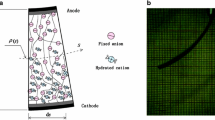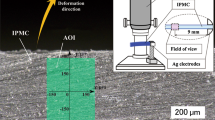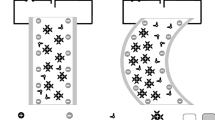Abstract
This paper addresses an “equivalent” electromechanical coupling coefficient that may be used in designing Ionic Polymer Metal Composite (IPMC) actuators. The coefficient is not a material constant and derived from equivalent bimorph beam model. The collective effect of the membrane thickness and operating voltage on the coefficient is demonstrated by using a design of experiment (DOE) of three and five levels of the two factors, respectively. Experiments and linear finite element analyses with MD.NASTRAN at DOE points are performed. The tip displacement and the coupling coefficient are reported and their response surface (RS) approximations as function of the thickness and voltage are constructed. Experiments and RS predictions indicate that actuator thickness and applied voltage are two interacting major factors for maximum tip displacement. The equivalent coupling coefficient is primarily driven by the thickness of actuator moreover voltage appears to contribute as the thickness increases. The initial curvature of the strips before electrical excitation is also shown to be a factor for “equivalent” coupling coefficient, it is not, however sufficient to explain the variation in the experimental data. A correction factor approach is proposed and applied to the straight beam tip displacement RS that filters out experimental variation. A corrected RS enables including the pre-imposed initial curvature as design parameter along with the actuator thickness and the operating peak voltage when predicting the tip displacement and the equivalent coupling coefficient.










Similar content being viewed by others
References
Bar-Cohen Y, Zhang Q (2008) Electroactive polymer actuators and sensors. MRS Bulletin 33:173–182
Shahinpoor M, Bar-Cohen Y, Simpson JO, Smith J (1998) Ionic polymer-metal composites (IPMCs) as biomimetic sensors, actuators and artificial muscles. Smart Mater Struct 7:15–30
Shahinpoor M, Kim KJ (2001) Ionic polymer-metal composites: I. Fundamentals. Smart Mater Struct 10:819–833
Shahinpoor M, Kim KJ (2005) Ionic polymer-metal composites: IV. Industrial and medical applications. Smart Mater Struct 14:197–214
Bar-Cohen Y (2000) Artificial muscles using electroactive polymers (EAP): capabilities, challenges and potential. artificial muscles using electroactive polymers (EAP). Available via http://hdl.handle.net/2014/18826. Accessed 05 August 2009.
Bar-Cohen Y (2001) Transition of EAP material from novelty to practical applications- are we there yet? In: Proceedings of SPIE EAPAD, SPIE's 8th annual ınternational symposium on smart structures and materials. no. 4329-02.
Nemat-Nasser S, Wu Y (2006) Tailoring the actuation of ionic polymer-metal composites. Smart Mater Struct 15:909–923
Nemat-Nasser S, Thomas C (2001) In: Bar-Cohen Y (ed) Electroactive polymer (EAP) actuators as artificial muscles—reality, potential and challenges, SPIE, Bellingham, WA, pp 139–191.
Lee JH, Nam JD, Choib H, Jung K, Jeon JW, Lee YK, Kim KJ, Tak Y (2005) Water uptake and migration effects of electroactive ion-exchange polymer metal composite (IPMC) actuator. Sens Actuators A 118:98–106
Gierke TD, Munn GE, Wilson FC (1981) The morphology in Nafion perfluorinated membrane products, as determined by wide- and small-angle x-ray studies. J Polym Sci Polym Phys Ed 19:1687–1704
Hsu WY, Gierke TD (1982) Elastic theory for ionic clustering in perfluorinated ionomers. Macromolecules 15:101–105
Roche EJ, Pineri M, Duplessix R, Levelut AM (1981) Small-angle scattering studies of Nafion membranes. J Polym Sci Polym Phys Ed 19(1):1–11
Xue T, Trent JS, Osseo-Asare K (1989) Characterization of Nafion membranes by transmission electron microscopy. J Membr Sci 45(3):261–271
Xue T, Longwell RB, Osseo-Asare K (1991) Mass transfer in Nafion membrane systems: effects of ionic size and charge on selectivity. J Membr Sci 58(2):175–189
James PJ, Elliott JA, McMaster TJ, Newton JM, Elliott AMS, Hanna S, Miles MJ (2000) Hydration of Nafion studied by AFM and x-ray scattering. J Mater Sci 35(20):5111–5119
Nemat-Nasser S (2002) Micromechanics of actuation of ıonic polymer-metal composites. J Appl Phys 92(5):2899–2915
Nemat-Nasser S, Li JY (2000) Electromechanical response of ionic polymer metal composites. J Appl Phys 87(7):3321–3331
Shahinpoor M (1995) Micro-electro-mechanics of ionic polymer gels as electrically controllable artificial muscles. J Intell Mater Syst Struc 6:307–317
Kanno R, Kurata A, Hattori M, Tadokoro S, Takamori T, Oguro K (1994) Characteristics and modeling of ICPF actuators In: Proceedings of Japan–USA symp. on flexible automation 2:691–698.
Kanno R, Hattori M, Tadokoro S, Takamori T (1996) Linear approximate dynamic model of ICPF actuator In: Proceedings of IEEE ınt. conf. on robotics and automation, Piscataway, NJ, IEEE, pp 219–225.
DeGennes P, Okumura K, Shahinpoor M, Kim K (2000) Mechanoelectric effects in ionic gels. Europhys Lett 40:513–518
Lee S, Park HC, Kim KJ (2005) Equivalent modeling for ionic polymer-metal composite actuators based on beam theories. Smart Mater Struct 14:1363–1368
Bonomo C, Fortuna L, Giannone P, Graziani S, Strazzeri S (2006) A model for ionic polymer metal composites as sensors. Smart Mater Struct 15:749–758
Lee S, Park HC, Kim KJ (2006) Modeling of an IPMC actuator-driven zero-net-mass-flux pump for flow control. J Intel Mater Syst Struct 17:533
Lee S, Kim KJ, Park IS (2007) Modeling and experiment of a muscle-like linear actuator using an ionic polymer-metal composite and its actuation characteristics. Smart Mater Struct 16:583–588
Nguyen TT, Goob NS, Nguyen VK, Yoo Y, Park S (2008) Design, fabrication and experimental characterization of a flap valve IPMC micropump with a flexibly supported diaphragm. Sens Actuators A 141:640–648
MD.NASTRAN Quick Reference Guide (2006).
Papila M, Sheplak M, Cattafesta LN (2008) Optimization of clamped circular piezoelectric composite actuators. Sens Actuators A 147:310–323
Ji A, Park HC, Nguyen QV, Lee JW, Yoo YT (2009) Verification of beam models for ıonic polymer-metal composite actuator. Journal of Bionic Engineering 6:232–238
Rossiter J, Stoimenov B, Mukai T (2007) A linear actuator from a single ionic polymer-metal composite (IPMC) strip In: Proceedings of SPIE electroactive polymer actuators and devices (EAPAD), San Diego, California, USA, no. 652421-8.
Stoimenov B, Rossiter J, Mukai T (2007) Manufacturing of ionic polymer metal composites (IPMCs) that can actuate into complex curves In: Proceedings of SPIE electroactive polymer actuators and devices (EAPAD), San Diego, California, USA, no. 65240.
Montgomery MA (1997) Response surface methodology, 2nd edn. Wiley, New York
Papila M, Haftka RT (2000) Response surface approximations: noise, error repair, and modelling errors. AIAA Journal 38:2336–2343
Yördem OS, Papila M, Menceloğlu YZ (2008) Effects of electrospinning parameters on polyacrylonitrile nanofiber diameter: an investigation by response surface methodology. Mater Des 26(1):33–44
Kim KJ, Shahinpoor M (2003) Ionic polymer-metal composites: II. Manufacturing techniques. Smart Mater Struct 12:65–79
Tang H-P, Nie T, Tang Y-J, Yin C-F, Tang C-X, Wang Q-Y (2008) Constitutive relationship of ıonic polymer-metal composite and static response character of its cantilever setup to voltage. J Cent South Univ Technol 15:387–391
Newbury KM, Leo D J (2002) Electrically induced permanent strain in ionic polymer-metal composite actuators In: Proceedings of smart structures and materials Vol. 4695.
Bandopadhya D, Bhattacharya B, Dutta A (2008) Active vibration control strategy for a single-link flexible manipulator using ıonic polymer metal composite. J Intell Mater Syst Struc 19:487–496
Bonomo C, Fortuna L, Giannone P, Graziani S (2005) Frequency response analysis of IPMC actuators by an IR system In: Proceedings of SPIE smart structures and materials Vol. 5759.
Acknowledgement
We kindly acknowledge the support for this work from the Sabanci University Internal Research Grant Program (contract number IACF06-00418), and The Scientific and Technological Research Council of Turkey-TÜBİTAK Grant 106M364.
Author information
Authors and Affiliations
Corresponding author
Rights and permissions
About this article
Cite this article
Çilingir, H.D., Papila, M. “Equivalent” Electromechanical Coefficient for IPMC Actuator Design Based on Equivalent Bimorph Beam Theory. Exp Mech 50, 1157–1168 (2010). https://doi.org/10.1007/s11340-009-9311-0
Received:
Accepted:
Published:
Issue Date:
DOI: https://doi.org/10.1007/s11340-009-9311-0




